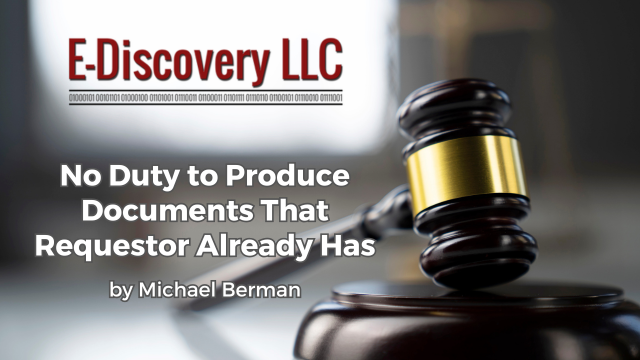
[EDRM Editor’s Note: This article was first published here on August 29, 2025. The opinions and positions are those of Michael Berman.]
In Rutherford v. Central Bank of Kansas City, 2025 WL 2432218, at *6-7 (W.D. Wash. Aug. 21, 2025), one of several issues was whether a litigant must produce information that was already in possession of the opponent’s counsel from other litigation. The court held that duplicative production was unnecessary; however, it ordered a “gap analysis.”
Rutherford was a class action in which plaintiff sued CBKC to recover damages for prepaid debit card fees. One issue was “whether CBKC should have to produce documents or information that is already in the possession of plaintiff’s counsel from the Brown litigation.” Id. at *3. The Rutherford court wrote:
Finally, there are several RFPs and interrogatories where CBKC objected on the grounds that the data requested was produced in Brown v. Stored Value, Cards, Inc., a case in the District of Oregon involving the same attorneys representing plaintiff in this case. CBKC states the discovery requests seek duplicative information.
Rutherford v. Central Bank of Kansas City, 2025 WL 2432218 (W.D. Wash. Aug. 21, 2025).
The Rutherford court wrote that: “Federal Rule of Civil Procedure 1 explains that the federal rules, including those governing discovery, should be ‘construed, administered, and employed by the court and the parties to secure the just, speedy, and inexpensive determination of every action and proceeding.’” Id. at *6. It wrote:
The Court accepts plaintiff’s contention that he seeks relevant information and documents that may not have been included in the Brown litigation. But to the extent such information and documents are already in the possession of plaintiff’s attorney and may be reviewed and used in this case, even if those documents are from the Brown litigation, CBKC should not be required to unnecessarily spend time and funds to duplicate that production or seek that information from third parties.
Id. at *6 (emphasis added).
But to the extent such information and documents are already in the possession of plaintiff’s attorney and may be reviewed and used in this case, even if those documents are from the Brown litigation, CBKC should not be required to unnecessarily spend time and funds to duplicate that production or seek that information from third parties.
Rutherford v. Central Bank of Kansas City, 2025 WL 2432218, at *6 (W.D. Wash. Aug. 21, 2025).
However, the court ordered a “gap analysis,” writing:
To the extent he has not done so to date, plaintiff should conduct a gap analysis and specify what information and documents he seeks from CBKC that is not duplicative of what plaintiff already has possession of, that was turned over in discovery in the Brown litigation. The parties should meet and confer to review the gap analysis, and to identify discoverable documents that plaintiff does not already have in their possession from the Brown litigation, within 14 days of this Order.
Id. at *6.
The court also ordered that:
Thus, plaintiff’s motion to compel documents that are duplicative of documents produced in the Brown litigation is conditionally denied. To avoid duplicative work and costs on CBKC’s part and CBKC is ordered to produce responsive documents (that plaintiff does not already have) within 30 days of this Order.
Id. at *7.
The same result could have been reached under Fed.R.Civ.P. 26(b). Rule 26(b)(2)(C)(i) states that, on motion “or on its own, the court must limit” the extent of discovery if the discovery “can be obtained from some other source that is more convenient, less burdensome, or less expensive….” Rule 26(b)(1) states that one proportionality factor to be considered is “the parties’ relative access to relevant information….”
Read the original article here.
Assisted by GAI and LLM Technologies per EDRM GAI and LLM Policy.


